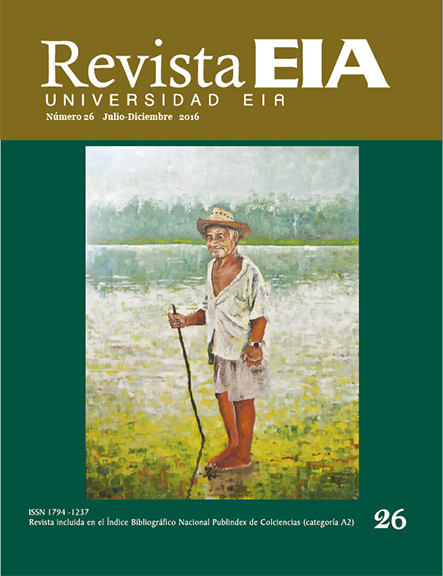DISEÑO Y DESARROLLO DE UN SISTEMA DE INTERACCIÓN PARA SU IMPLEMENTACIÓN EN UN AULA DE CLASE INTELIGENTE
DISEÑO Y DESARROLLO DE UN SISTEMA DE INTERACCIÓN PARA SU IMPLEMENTACIÓN EN UN AULA DE CLASE INTELIGENTE

Copyright statement
The authors exclusively assign to the Universidad EIA, with the power to assign to third parties, all the exploitation rights that derive from the works that are accepted for publication in the Revista EIA, as well as in any product derived from it and, in in particular, those of reproduction, distribution, public communication (including interactive making available) and transformation (including adaptation, modification and, where appropriate, translation), for all types of exploitation (by way of example and not limitation : in paper, electronic, online, computer or audiovisual format, as well as in any other format, even for promotional or advertising purposes and / or for the production of derivative products), for a worldwide territorial scope and for the entire duration of the rights provided for in the current published text of the Intellectual Property Law. This assignment will be made by the authors without the right to any type of remuneration or compensation.
Consequently, the author may not publish or disseminate the works that are selected for publication in the Revista EIA, neither totally nor partially, nor authorize their publication to third parties, without the prior express authorization, requested and granted in writing, from the Univeridad EIA.
Show authors biography
Las aulas de clase inteligente son un nuevo paradigma educativo cuyo objetivo es determinar mediante un conjunto de sensores que esta sucediendo dentro del aula, y a partir de esta información y usando estrategias de inteligencia artificial inferir que variaciones metodológicas o de contenido deben ser aplicadas por parte del docente, con el fin de optimizar las practicas pedagógicas. Un componente importante de estas aulas es el uso de nuevas estrategias de interacción, que facilitan el manejo de los contenidos pedagógicos utilizados. En este artículo se presenta el diseño y desarrollo de un sistema de interacción, que usa diferentes estrategias para interactuar con los contenidos propuestos por el aula de clase inteligente. Estas estrategias de interacción están basadas en gestos, superficies interactivas no instrumentadas y sistemas de pulsación gestual. Finalmente, el artículo propone pruebas experimentales para validar las diferentes formas de interacción propuestas.
Article visits 1173 | PDF visits 463
Downloads
- Chen, C-C., Huang, T-C. (2012) Learning in a u-Museum: Developing a context-aware ubiquitous learning environment. Computers & Education, Volume 59, Issue 3, pp. 873 – 883.
- Papatheodorou, C., Antoniou, G., y Bikakis, A. (2010) On the Deployment of Contextual Reasoning in Ambient Intelligence Environments. Sixth International Conference on Intelligent Environments (EI), pp. 13 – 18.
- Bailly, G., Müller, J. y Lecolinet, E. (2012) Design and evaluation of finger-count interaction: Combining multitouch gestures and menus. International Journal of Human Computer Studies, Volume 70, Issue 10, pp. 673 – 689.
- Zhao, J., Soukoreff, R., Ren, X., y Balakrishna, R. (2014) A model of scrolling on touch-sensitive displays. International Journal of Human Computer Studies, Volumen 72, Issue 12, pp. 805 - 821.
- Nacher,V., Jaen, J., Navarro, E., Catala, A., González, P. (2014) Multi-touch gestures for pre-kindergarten children. pp.7-12.
- Novotný, M., Lacko, J., Samuel ík, M. (2013) Applications of Multi-Touch Augmented Reality System in Education and Presentation of Virtual Heritage, VIS GRAVIS, pp 2-4.
- Seo, W., Yeol Lee, J. (2013) Direct hand touchable interactions in augmented reality environments for natural and intuitive user experiences, KISTI, 245 Daehak-ro, Yuseong-gu, Daejeon, 305-806, South Korea, pp 5-8.
- Krejov, P., Gilbert, A., y Bowden, R. (2014) A Multitouchless Interface Expanding User Interaction, IEEE Computer Society 0272-1716, pp 2-8.
- Diaz C., Hincapié, M., Moreno, G. y Guirales, E. (2015) Descripción de un Sistema de Reconocimiento de Gestos Para su Implementación en una Aula de Clase Inteligente. Pendiente de Publicación.
- Al Delail, B., Weruaga, L., y Zemerly, J. (2012) CAViAR: Context Aware Visual indoor Augmented Reality for a University Campus, IEEE/WIC/ACM International Conferences, pp 2-4. +
- Goldstone, W. (2011) Unity 3.x Game Development Essentials. Packt Publishing, Second Edition.
- Arranz, J. (2013) Diseño, optimización y análisis de sistemas basados en técnicas láser, para el modelado geométrico, registro y documentación, aplicados a entidades de interés patrimonial, Tesis doctoral, pp 217-2225, pp 334.
- Magallón, M. (2013) Sistema Interactivo para Manejo de electrodomésticos en Entornos Domésticos. Trabajo de grado en Ingeniería de Telecomunicaciones, Universidad de Zaragoza.




